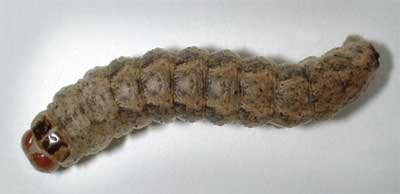Wooster, Ohio
July 16, 2009
Source: Andy Michel, OARDC,
Ohio State
University Extension
An emerging corn pest, first found
in Ohio in 2006, continues to increase in numbers, and Ohio
State University Extension entomologists are striving to educate
farmers on identification and management before it causes any
significant damage.
Western bean cutworm, a pest more common in Western corn
producing states, has been making its way east for several
years. Found for the first time in Ohio three years ago, the
pest feeds on the plant’s tassels, silks and ears. Yield losses
can be significant. In Nebraska, yield losses from one larva per
corn plant at dent stage were estimated at 3.7 bushels per acre.
In Colorado, yield losses were estimated at 30 percent to 40
percent in plants with heavily infested ears. Feeding can also
contribute to secondary injury from diseases.
“This is the fourth year we are seeing Western bean cutworm, but
what is concerning us is the number of adult moths we are
catching in the traps we have set up throughout Ohio,” said Andy
Michel, an OSU Extension entomologist with the Ohio Agricultural
Research and Development Center. “In 2006, we caught three in
the traps. In 2007, we caught six moths. Last year, that number
jumped to 150. As of July 16, we have already caught 76 moths.
This same time last year, we had only caught 10.”
Michel is recommending growers scout their cornfields for egg
masses and larvae. Peak flight of adults is mid- to late July.
Adults will lay eggs on the upper leaves of the corn plants, and
once the eggs hatch, larvae begin feeding on the tassels, silks
or ears of the corn, depending on the crop’s growth stage. When
done feeding, the larvae will drop from the plant, burrow into
the soil and overwinter, where they emerge the following year to
begin the cycle again.
“We know that Western bean cutworm can overwinter in Michigan,
so it stands to reason that the pest can overwinter in Ohio, as
well,” said Michel. “But at this stage, we aren’t sure if the
adults we are trapping overwintered or if storms carried them
from other states into Ohio. More than likely the catches we are
seeing are from overwintering populations.”
Western bean cutworm egg masses (20-100 eggs) are usually
randomly clustered, rather than deposited neatly in rows. They
start out white, then slowly change to tan and then a deep
purple. The larvae hatch about 48 hours later. Michel said that
the purple egg color is characteristic of Western bean cutworm.
“No other corn pest, that I’m aware of, has this distinct egg
color,” said Michel.
Western bean cutworm larvae can be confused with other corn
pests, said Michel, specifically corn earworm.
“The pest has more characteristics of corn earworm than, say,
corn borer. One difference is that the Western bean cutworm
larva has two broad, brown stripes behind the head and corn
earworm larva doesn’t have that,” said Michel. “But the main
difference is that Western bean cutworm is not cannibalistic
like corn earworm. If you find multiple larvae on a corn plant,
then most likely it’s Western bean cutworm.”
Michel said that growers should inspect at least 20 consecutive
corn plants at five random locations throughout the field to
look for egg masses and larvae. Economic threshold is 5 percent
of plants that contain either egg masses or larvae.
“If you find egg masses and the corn has already tasseled, there
is a better window for control,” said Michel. “If the crop has
not yet tasseled, you have to watch the plants more closely for
larvae, because they will hide in the whorl of the plant waiting
for the right time to feed on the silks and ears. Larvae will
either burrow into the top of the ear, or if too many larvae are
trying to get into the ear at one location, the pest will chew
through the husk at the middle of the ear, and feed on the ear
that way.”
In Ohio, adult moths have been found as far east as Wayne
County. So far, no egg masses, larvae or crop damage has been
found.
“It’s probably just a matter of time. It might take a couple of
years before seeing economic damage, but it’s something growers
will have to really watch out for,” said Michel.
For more information on Western bean cutworm, log on to
http://entomology.osu.edu/ag/.
|
 |
|
Cutworm
eggs
|
|
 |
|
Cutworm
larvae
|
|
 |
|
Cutworm
injury
|
|
|